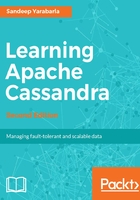
Creating a keyspace
A keyspace is a collection of related tables equivalent to a database in a relational system. To create keyspace, issue the following statement in the CQL shell:
cqlsh> CREATE KEYSPACE "users"
WITH REPLICATION = {
'class': 'SimpleStrategy', 'replication_factor': 1
};
Here, we created a keyspace called users. When we create a keyspace, we have to specify replication options. Cassandra provides several strategies for managing replication of data; SimpleStrategy is the best strategy as long as your Cassandra deployment does not span across multiple data centers. The replication_factor value tells Cassandra how many copies of each piece of data are to be kept in the cluster; since we are only running a single instance of Cassandra, there is no point in keeping more than one copy of the data. In a production deployment, you would certainly want a higher replication factor; three is a good place to start.
A few things at this point are worth noting about CQL's syntax:
- It's syntactically very similar to SQL; as we further explore CQL, the impression of similarity will not diminish.
- Double quotes are used for identifiers such as keyspace, table, and column names. As in SQL, quoting identifier names is usually optional, unless the identifier is a keyword or contains a space or another character that will trip up the parser.
- Single quotes are used for string literals; the key value structure we use for replication is a map literal, which is syntactically similar to an object literal in JSON.